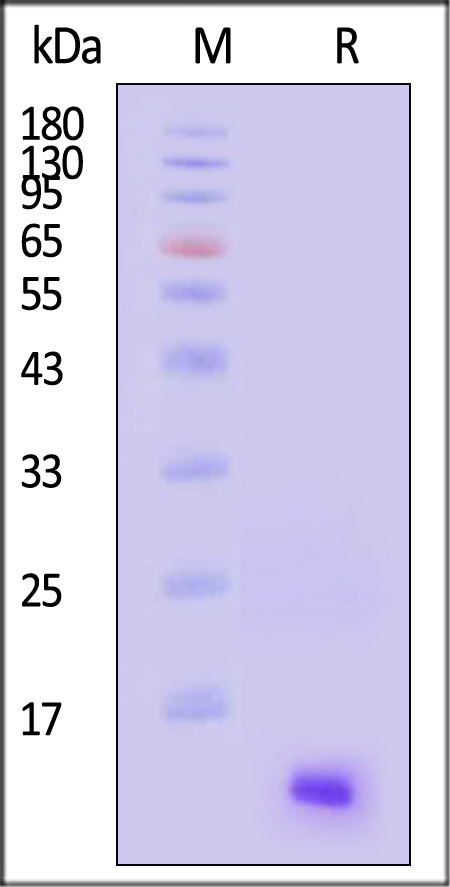分子别名(Synonym)
C-X-C motif chemokine 13,Angie,B cell-attracting chemokine 1,BCA-1,B lymphocyte chemoattractant,CXC chemokine BLC,Small-inducible cytokine B13,CXCL13,BCA1,BLC,SCYB13
表达区间及表达系统(Source)
Human CXCL13 Protein, His Tag (CX3-H1249) is expressed from E. coli cells. It contains AA Val 23 - Pro 109 (Accession # O43927-1).
Predicted N-terminus: Met
Request for sequence
蛋白结构(Molecular Characterization)

This protein carries a polyhistidine tag at the N-terminus.
The protein has a calculated MW of 12.2 kDa. The protein migrates as 12-15 kDa when calibrated against Star Ribbon Pre-stained Protein Marker under reducing (R) condition (SDS-PAGE).
内毒素(Endotoxin)
Less than 1.0 EU per μg by the LAL method.
纯度(Purity)
>90% as determined by SDS-PAGE.
制剂(Formulation)
Lyophilized from 0.22 μm filtered solution in PBS, pH7.4 with trehalose as protectant.
Contact us for customized product form or formulation.
重构方法(Reconstitution)
Please see Certificate of Analysis for specific instructions.
For best performance, we strongly recommend you to follow the reconstitution protocol provided in the CoA.
存储(Storage)
For long term storage, the product should be stored at lyophilized state at -20°C or lower.
Please avoid repeated freeze-thaw cycles.
This product is stable after storage at:
- -20°C to -70°C for 12 months in lyophilized state;
- -70°C for 3 months under sterile conditions after reconstitution.
电泳(SDS-PAGE)

Human CXCL13 Protein, His Tag on SDS-PAGE under reducing (R) condition. The gel was stained with Coomassie Blue. The purity of the protein is greater than 90% (With Star Ribbon Pre-stained Protein Marker).
背景(Background)
CXCL13, originally known as BLC (B-lymphocyte chemoattractant) or BCA-1 (B cell-attracting chemokine 1), is a homeostatic chemokine. It is constitutively secreted by stromal cells in B-cell areas of secondary lymphoid tissues (follicles), such as spleen, lymph nodes, tonsils, and Peyer's patches. CXCL13 plays a key role in orchestrating cell migration within spatially distinct regions of the secondary lymphoid organs. It strongly attracts B lymphocytes while promoting migration of only small numbers of T cells and macrophages. CXCL13 exerts its functions through its receptor CXCR5, which initially, was isolated from Burkitt Lymphoma and therefore designated as Burkitt's lymphoma receptor 1 (BLR1).























































 膜杰作
膜杰作 Star Staining
Star Staining











